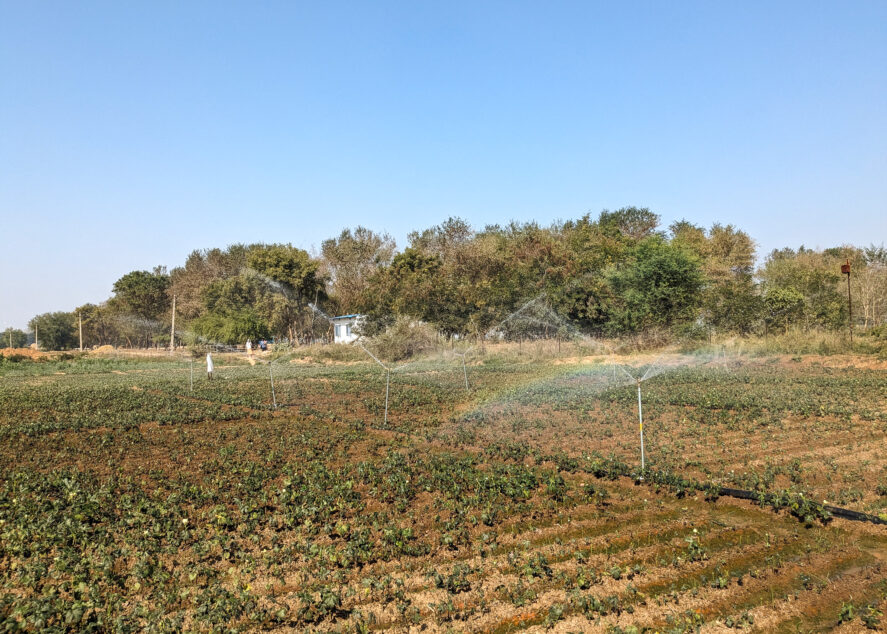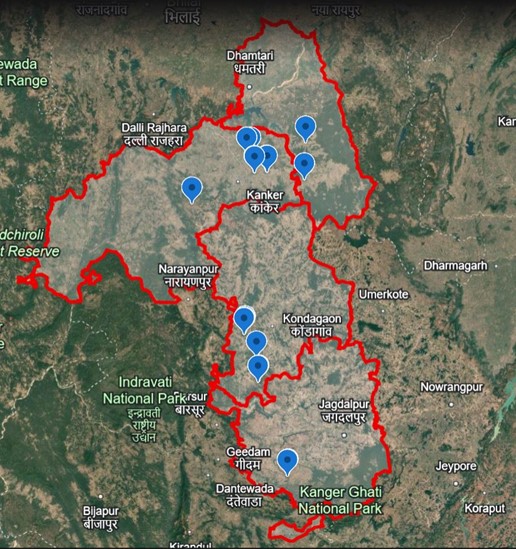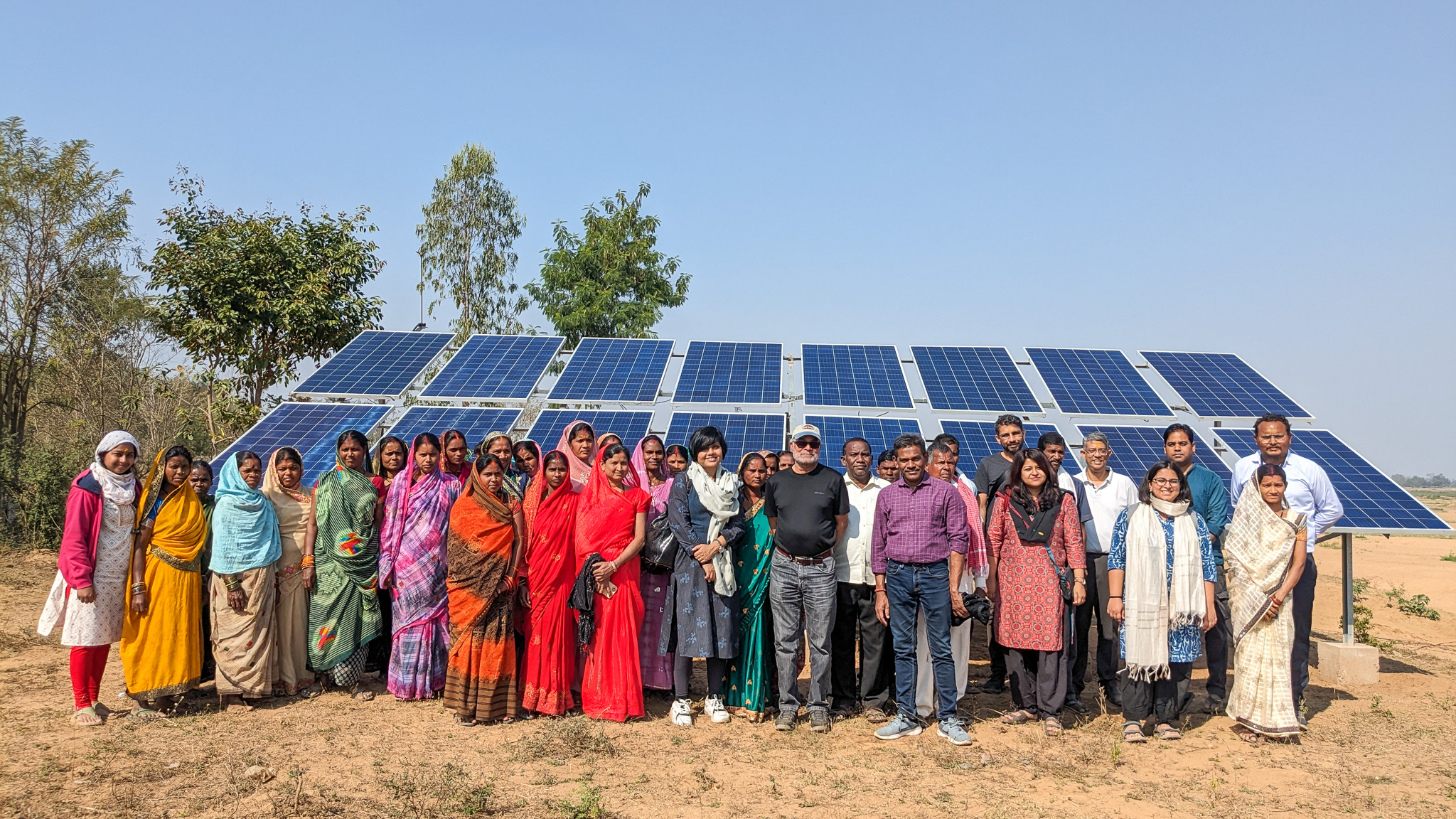Building Climate-Resilient Agriculture with Community-Owned Solar Irrigation

The agricultural sector accounts for approximately 14% of India’s total greenhouse gas emissions, with 17.5% contributed by rice-based agricultural systems. Mitigation efforts have therefore prioritized two major themes: reducing the area under water-intensive paddy cultivation and lowering dependency on diesel or electric pumps for irrigation. Diversification of farming away from water-intensive paddy towards pulses, oilseeds, and vegetables—not only to reduce emissions but also to improve soil health, lower water use, and enhance farmers’ capacity to adapt to climate shocks—has been suggested as a solution to address this issue. Similarly, the solarization of irrigation systems is an important part of the movement toward cleaner energy use in agriculture.
TCI’s ongoing initiative in Chhattisgarh, “Transformation of Agricultural Systems for Climate Resilience,” contributes to this debate by identifying credible pathways to diversify away from rice using a randomized control trial that spans 80 villages in four districts. By promoting the cultivation of climate-smart crops and reducing dependence on paddy, the project supports both climate mitigation and adaptation. The program includes:
- Education and awareness through information on climate-smart and sustainable farming practices
- Improved market access via quality inputs and post-harvest processing, and marketing facilities
- Community-based irrigation infrastructure, including water-harvesting structures and solar lift systems to enable non-paddy crop cultivation, particularly in underutilized upland areas
In this post, we focus on the third intervention of community-owned and managed solar lift irrigation systems implemented by our partner, Professional Assistance for Development Action (PRADAN).
Installing solar lift irrigation systems in Chhattisgarh
Primary data collected during our study suggests that the project area predominantly consists of tribal households, where 91% of the population relies on cultivation as their primary source of income. Cultivation is mainly rainfed, where kharif (summer) is the primary cultivation season. About 98% of households cultivate during the monsoon (kharif) season, and only 12% of households grow alternative crops during the dry rabi and zaid periods. As one would expect, in kharif, paddy is the key crop, with 96% of households growing monsoon paddy and 48% selling paddy to the government through minimum support prices (MSPs). We found that limited irrigation access, in the form of borewells on uplands and midlands and a combination of borewells and canals on the lowland—available to just 30% of households—restricts the potential for agricultural diversification.
To improve access to irrigation, we worked with PRADAN to establish community-owned and managed solar-powered lift irrigation systems in 10 villages and farm ponds in 5 villages across the Bastar, Dhamtari, Kondagaon and Kanker districts. The initiative focuses on the following objectives:
- Ensuring water access during dry seasons, especially for upland plots that are left fallow
- Enabling the cultivation of less water-intensive crops, as well as high-value crops, during non-monsoon periods
- Building a prototype for women-led, community-owned irrigation management that utilizes surface and subsurface sources of water
The initiative aims to help build advocacy for integrating a community-owned irrigation model in state government schemes, such as the Saur Sujala Yojana, and central government schemes like Pradhan Mantri Kisan Urja Suraksha evam Utthaan Mahabhiyan (PM-KUSUM). The fact that PM-KUSUM’s budgeted 26 billion rupees for 2026 shows that the solarization of agriculture is a key policy priority for the state.

Blue markers show where solar lift infrastructure was built as part of the TCI project in Chhattisgarh.
The solar lift irrigation system, deployed across 10 villages, harnesses the power of 16 solar panels of 330W each, leading to a total generation capacity of 5.28 kW per installation. These solar panels can typically operate for 4 to 6 hours per day and under good weather conditions, they could generate between 21.12 and 26.40 kWh/day. This clean energy powers 5 horsepower submersible pumps in each village, enabling efficient water lifting from depths of up to 30 meters and distribution over distances of 500–700 meters, collectively irrigating a command area of 200 hectares. Each unit typically irrigates around 9 hectares of land and supports an average of 15 farming households through a pipe network with outlets available at the farms of the participating farmers.
Importantly, these systems utilize surface and sub-surface water sources instead of relying on groundwater. The project was intentionally designed to promote sustainable practices and reduce the risk of groundwater over-extraction. By utilizing 5 horsepower pumps and drawing from surface and sub-surface water sources, the system naturally limits excessive water use. As a result, farmers are encouraged to use the lift irrigation system for less water-intensive crops like vegetables, pulses and oilseeds, supporting both resource conservation and crop diversification.
In India, the dominance of paddy cultivation and unsustainable irrigation practices driven by subsidies and free electricity in some regions has become a serious concern, especially in Punjab and Haryana. As India’s “rice bowl,” it is important for Chhattisgarh to incorporate the lessons from other states’ experiences to avoid any potential over-exploitation of groundwater resources. While subsidized electricity is available in Chhattisgarh, the cost of setting up irrigation infrastructure, such as borewells for an individual farmer, remains prohibitively high, especially for marginal and smallholder farmers who form the majority of the agrarian households in the state. Studies suggest that individual solar pumps are likely to be underutilized, and with increasing subsidies under various state and central government schemes, this suggests sub-optimal return on investment, which can be addressed through the community model.
Promoting community ownership
PRADAN organized sensitization and context-building meetings with village communities to initiate the intervention. These meetings served to identify irrigation sites, address community concerns and communicate the benefits of the proposed irrigation systems. Special attention was given to highlighting the sustainability of the technology and its positive implications for agriculture. Additionally, communities were introduced to climate-resilient crops that could be cultivated with the system. The meetings were inclusive, involving a broad cross-section of community members, and actively incorporated their perspectives. This approach was built on community trust and ensured the project resonated with local values.

Staff from TCI and PRADAN pose with farmers in front of a solar panel array used for lift irrigation. (Photo by TCI)
Afterwards, the participants engaged in resource mapping exercises to identify key water sources within a village, such as dug wells, borewells, lakes and streams, and mapped the locations of fields, homesteads, forest areas, etc. This collaborative effort helped to create a comprehensive understanding of the village’s water landscape and points of access where a community-based lift irrigation system would be feasible to build.
After the communities identified and selected suitable project sites in each of the treatment villages, they formed water user associations (WUAs) to oversee and manage the irrigation systems. These associations are structured as local, democratic, community-led bodies that foster inclusive participation, collective decision-making and a strong sense of ownership among members. Each WUA plays a central role in planning and implementing the day-to-day operations of the irrigation system. They are responsible for establishing rules for equitable water distribution, assigning maintenance responsibilities and creating transparent mechanisms for grievance redressal. To promote accountability and ensure the long-term financial sustainability of the infrastructure, WUAs also collect nominal user fees from participating households. These funds are pooled locally and used for routine maintenance, minor repairs and administrative costs, thereby reducing dependency on external support and enhancing the resilience of the system.
Driving diversification
Our theory of change suggests that this intervention holds significant potential to drive a shift in agricultural practices in the villages. Zero fuel costs after installation are likely to result in major savings over time, which in turn could lead to increased cropping intensity and income. By introducing sustainable irrigation infrastructure and promoting climate-resilient cropping patterns, the initiative aims to enhance productivity, reduce reliance on traditional paddy cultivation and encourage the adoption of diversified, market-aligned crops. This transformation is expected to not only improve household incomes but also strengthen resilience to climate variability, ultimately leading to more sustainable and adaptive farming systems in the region. Furthermore, the potential environmental benefits extend beyond the reduced carbon footprint of solar power. The system aims to reduce the pressure on groundwater resources and improve soil health through increased organic matter content in previously fallow soils and better nutrient cycling from diversified crop rotations. The infrastructure established by TCI-PRADAN is likely to enable members of the WUAs to cultivate high-value crops such as vegetables, pulses and oilseeds during the dry season, periods that were previously left fallow. This could not only contribute to income generation but also enhance food security and nutrition through increased availability of fresh produce and greater dietary diversity throughout the year.
The solar lift irrigation initiative further demonstrates the transformative potential of appropriate technology combined with community-managed implementation. The intervention has provided an impetus for diversification efforts that allow for enhancing climate resilience and improving livelihoods at the same time. While there were several challenges, such as identifying perennial sources of water, the key achievements include the successful deployment of 10 solar lift systems serving close to 240 farming households, with a capacity to generate 52.8 kW of energy and irrigate around 200 hectares of land. Moving forward, priorities include an endline survey to further evaluate the impact of the initiatives, consolidating the sustainability of existing systems, refining the implementation approach and engaging with state and central governments to advocate for scaling up the initiative and integrating it into existing solar irrigation schemes.
Aishwarya Gawali is an associate researcher at the TCI Center of Excellence in New Delhi, India.
Pallavi Rajkhowa is an associate research fellow at the TCI Center of Excellence in New Delhi, India.
Andaleeb Rahman is a research associate at TCI.
Featured image: Sprinklers are used to water okra on a farm in Chhattisgarh. (Photo by TCI)

